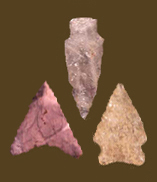
ADENADefining Attributes Chronology Description Haft Element: The type is often divided into two variants, based on the shape of the base: long rounded and square stemmed. The classic form is often called a “beaver-tail.” In general, the stem is broad, long, contracted, lobate or “beaver tail,” or square in outline. Bases can be ground. Size: A majority of Adena points measure between 34 mm and 150 mm in length, with an average of 70 mm. The width ranges from 17 mm to 43 mm, with an average of 28 mm, while the thickness ranges from 7 mm to 17 mm, with an average of 10 mm. However, points that are far larger than this are often found. Technique of manufacture: Most classic Adena points display excellent soft percussion flaking, followed by pressure flaking. Material: Adenas are made primarily from cryptocrystalline materials, although other stones are sometimes used. In the area surrounding Zekiah Swamp on the lower Potomac, Wanser (1982) found that 4 of 6 inventoried Adena points were rhyolite, with 1 quartzite and 1 chalcedony. Discussion Adena points have been found at several sites on Maryland’s Eastern Shore, part of the Delmarva Adena complex that existed between 1,800 to 2,500 years ago. Most of these points, often associated with caches, have been recovered along eroding shorelines or through non-professional collecting. The sites include Maiden Point (18TA233), Henckel Farm (18TA347), Benoni’s Point (18TA345), Martingham (18TA405), and Sandy Hill (18D030), an Early Woodland base camp that also contained numerous human burials. The Denton Adena cache (18CA181) contained seven large Robbins leaf-shaped Adena blades/bifaces made of Flint Ridge chalcedony (Lowery 1995). On Maryland’s Western Shore, the West River site (18AN18) had a number of Adena points made of chert, chalcedony, and jasper (Ford 1976). Pig Point (18AN50), a large Adena mortuary complex along the Patuxent River, is the first professionally-excavated Adena period site in Maryland. A number of large, “killed” (broken) Adena-Robbins points, all made from non-local chert and chalcedony, have been recovered at the site (Luckenbach 2013). Lowery (2012) and others have noted that both Adena and Hopewell artifacts are found on some sites in the Middle Atlantic region, and this is part of Lowery’s reasoning for the idea of a Delmarva Adena-Hopewell Complex extending from 500 BC to at least 450 AD. The Pig Point site in Anne Arundel County is one with Adena and Hopewell artifacts (Luckenbach 2011b). A small number of Hopewell-era projectile points have been reported in Maryland, most commonly on the Delmarva Peninsula. There are two types: the broad, corner notched Snyder point, and the side or corner notched Hopewell point. The latter can be hard to distinguish from other types if they are not made from exotic materials (Luckenbach 2011b). Defined in Literature Other Names Used References |
![]()
Search by Shape:
(See Projectile Point Typology) |

|
Thank you for visiting our website. If you have any
questions, comments, Copyright © 2002 by |

|

